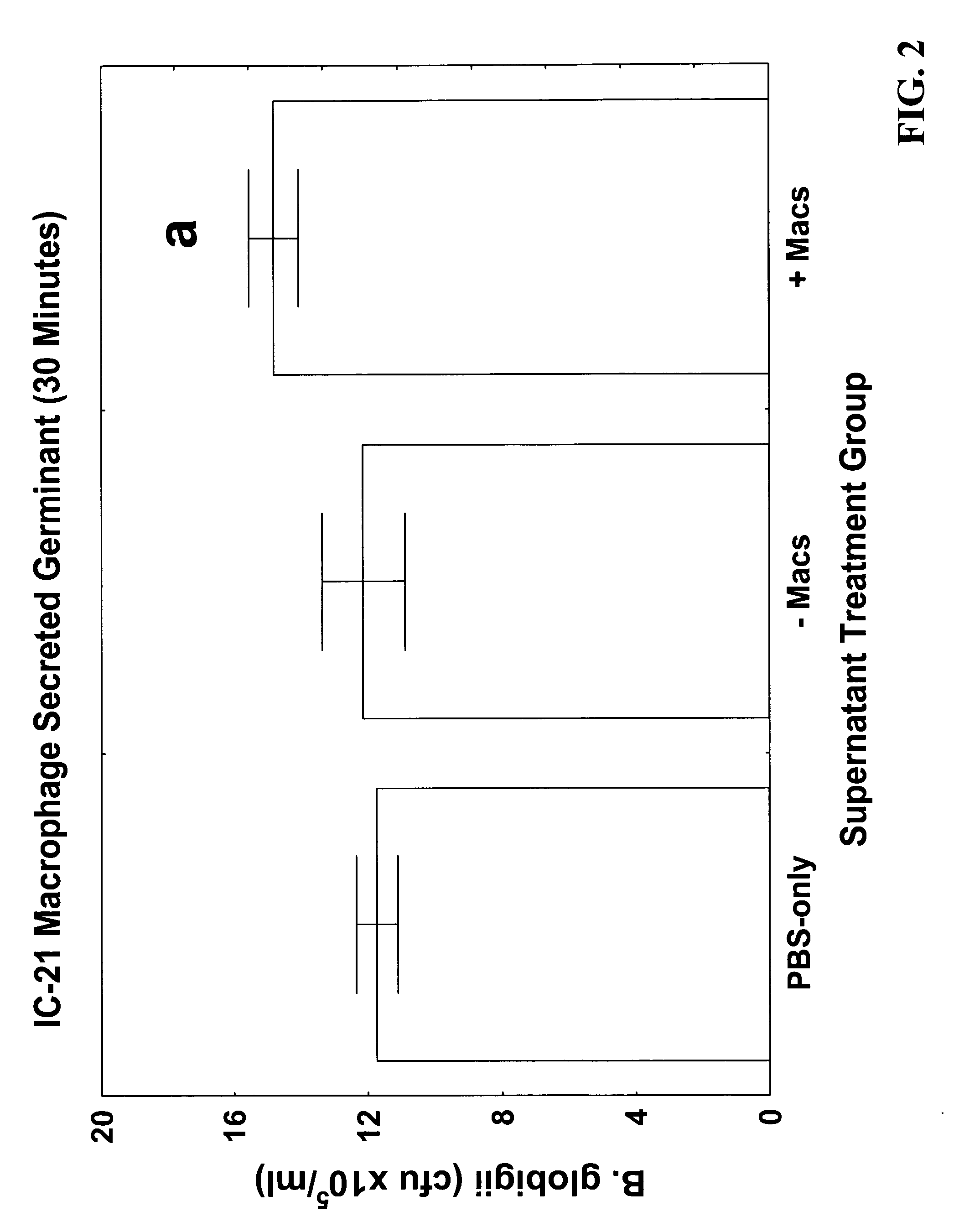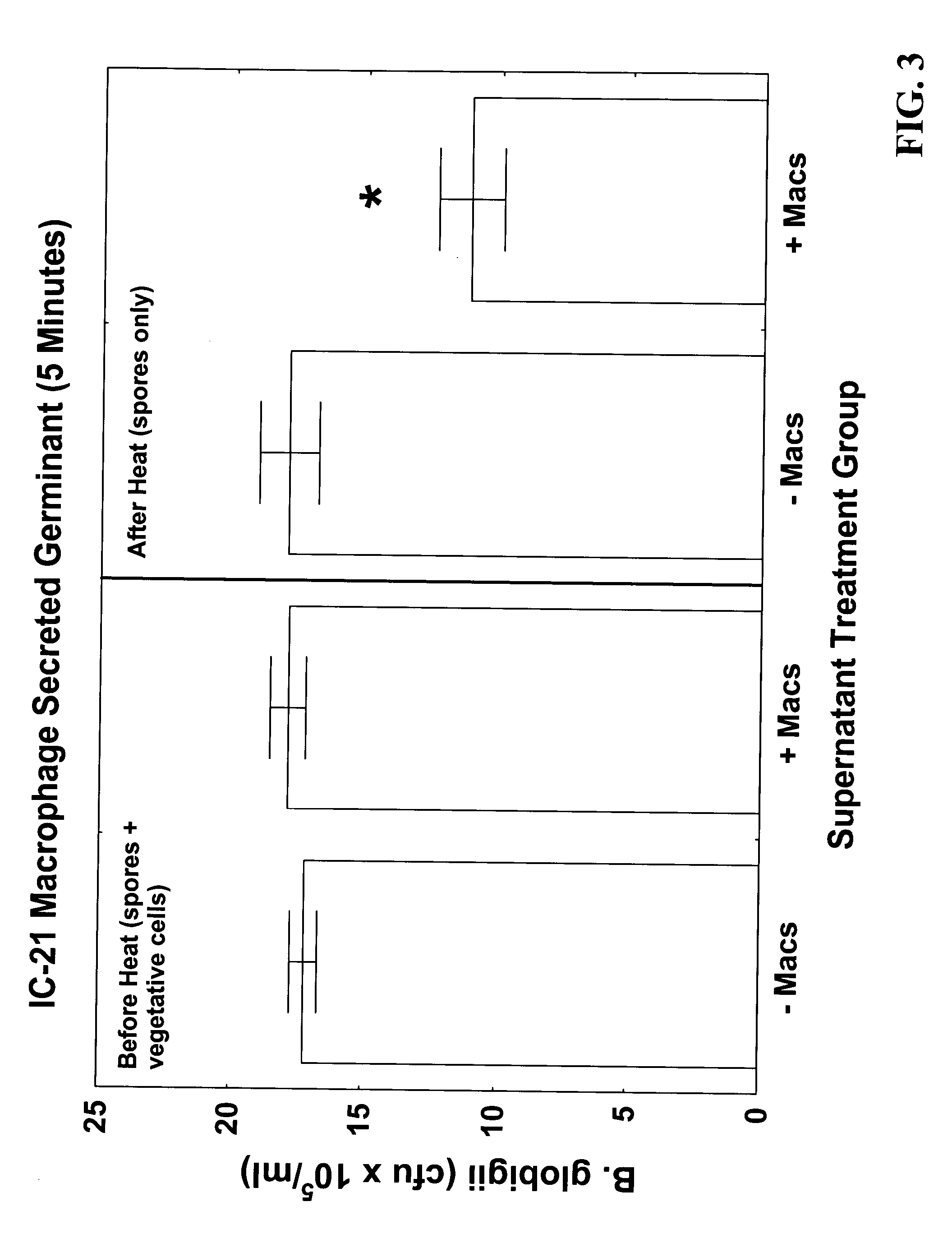Germinant produced from IC-21 macrophages, method and use thereof
a technology of ic-21 macrophages and germinants, applied in the field of spore germinants produced by ic21 macrophages, can solve the problems of special heat condition requirements, inefficiency or lack of efficacy, and inefficiency and special heat condition requirements
- Summary
- Abstract
- Description
- Claims
- Application Information
AI Technical Summary
Benefits of technology
Problems solved by technology
Method used
Image
Examples
example 1
[0023] IC-21 macrophage produced germinant was produced and tested as a germinant. 1×106 B. globigii spores were incubated for 1 hour at 37° C. under saturating humidity in an atmosphere of 5% CO2 and 95% air with 1×106 IC-21 macrophages (designated as “+Macs”) and separately with media alone (control group designated as “−Macs”). After the 1 hour incubation, the supernatant was filter sterilized with a 0.2 μm filter and tested as a germinant on a fresh preparation of spores. The +Mac supernatant and −Macs supernatant were added, in separate test batches, to 1×106 B. globigii spores under incubation conditions for 30 minutes. After this incubation, colony forming units (CFU) were determined before heat treatment (listed as “Before Heat”) and after heat treatment (listed as “After Heat”), as shown in FIG. 1. Values indicate mean ±SEM (n=4 per group). Asterisks indicate significance (p<0.05) as determined using a one-way ANOVA with an LSD post-hoc comparison. The process was repeated ...
example 2
[0025] IC-21 macrophage produced germinant was produced and tested as a germinant. 1×106 B. globigii spores were incubated for 1 hour at 37° C. under saturating humidity in an atmosphere of 5% CO2 and 95% air with 1×106 IC-21 macrophages (designated as “+Macs”) and separately with media alone (designated as “−Macs”). After the 1 hour incubation, the supernatant was filter sterilized with a 0.2 μm filter and tested as a germinant on a fresh preparation of spores. The +Mac supernatant and −Macs supernatant were added, in separate test batches, to 1×106 B. globigii spores under incubation conditions for 30 minutes. For comparison, 1×106 spores were also incubated with PBS for 30 minutes. After this incubation period, colony forming units (CFU) were determined before heat treatment, as shown in FIG. 2. Values indicate mean ±SEM (n=4 per group). aIndicates significance (p=0.06) as determined using a one-way ANOVA with an LSD post hoc comparison.
example 3
[0026] IC-21 macrophage produced germinant was produced and tested as a germinant. 1×106 B. globigii spores were incubated for 1 hour at 37° C. under saturating humidity in an atmosphere of 5% CO2 and 95% air with 1×106 IC-21 macrophages (designated as “+Macs”) and separately with media alone (designated as “−Macs”). After the 1 hour incubation, the supernatant was filter sterilized with a 0.2 μm filter and tested as a germinant on a fresh preparation of spores. The +Mac supernatant and −Macs supernatant were added, in separate test batches, to 1×106 B. globigii spores under incubation conditions for 5 minutes. After this incubation, colony forming units (CFU) were determined before heat treatment (listed as “Before Heat”) and after heat treatment (listed as “After Heat”), as shown in FIG. 3. Values indicate mean ±SEM (n=4 per group). Asterisks indicate significance (p<0.05) as determined using a one-way ANOVA with an LSD post-hoc comparison.
[0027] As seen in Examples 1-3, germinan...
PUM
| Property | Measurement | Unit |
|---|---|---|
| temperature | aaaaa | aaaaa |
| temperature | aaaaa | aaaaa |
| temperature | aaaaa | aaaaa |
Abstract
Description
Claims
Application Information
 Login to View More
Login to View More - R&D
- Intellectual Property
- Life Sciences
- Materials
- Tech Scout
- Unparalleled Data Quality
- Higher Quality Content
- 60% Fewer Hallucinations
Browse by: Latest US Patents, China's latest patents, Technical Efficacy Thesaurus, Application Domain, Technology Topic, Popular Technical Reports.
© 2025 PatSnap. All rights reserved.Legal|Privacy policy|Modern Slavery Act Transparency Statement|Sitemap|About US| Contact US: help@patsnap.com



